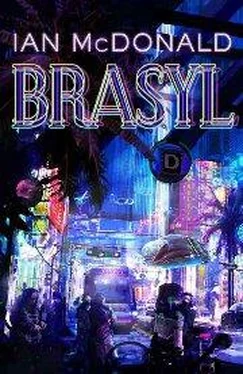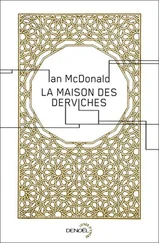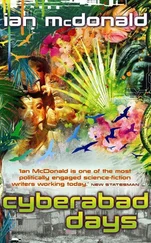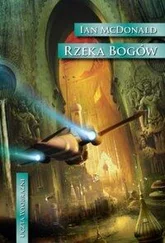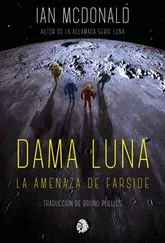The greater party of the Cidade Maravilhosa had passed down the white-water gut; now the children, grinning and wet in their little skimming pirogues, took to the run. They waved to Caixa; she stood fast, the cross of Our Lady of All Worlds gripped in her wounded fist. Falcon shook his head.
“I cannot believe in such a world.”
“The world persists whether you believe it or not.” Quinn rose. “I must be getting on now. They are waiting for me.” He dipped his head toward the forest edge, dark and dripping. Falcon imagined he saw two women standing there in the dim, one a white woman with a head of curling golden hair, the other of an Asiatic cast and complexion, her hair a dark red. A black man waited under the eaves of the forest. All wavered like mist on the edges of Falcon’s perception; then he picked his way over the stones to the shore. When he looked back only the smoldering fire remained.
The Iguapá nation had passed, the children’s boats melted into the mist. Caixa had rerurned the cross to its figurehead place in the canoe; the paddlers pushed out. Waitacá gave a cry; an object running the gut. For an instant Falcon thought it was a capsized canoe, a great war boat. It cleared the run into slack water. The paddlers hauled it in. An angel face, blank yet smiling, gazed up at the fast-running gray mist. Its hands held a three-bladed sword; an angel fallen from the pinnacles of Nossa Senhora da Varzea. Falcon pushed it out into the stream, and the rippling water running fast and chattering over the stones took it and carried it away.
Abia: Uninitiated novice.
Agogo: Twin-horned metal percussion instrument used in candomble and capoeira.
Aîuri: Tribal council.
Alabe: First drummer and song leader; male office in candomblé.
Aldeia: Missionary Indian village, usually Jesuit.
Alva: Skin-color descriptor: pure white, considered rare in Brazil.
Amaci: Herbal infusion used for purification.
Assentamento: Assemblage of objects, herbs, and water fed and venerated as the conjunction of a person and orixá.
Axé: Transformative power: magic, the force that makes things happen.
Baiana: From the state of Bahia, latterly come to mean the quasi-traditional costume of women from Salvador.
Baile: “Dance,” used in Rio in the sense of an impromptu street sounddsystem party, giving rise to the popular carioca genre of “baile-funk.” Constantly evolving.
Bairro: Official city district.
Barracão: Main ceremonial room of the terreiro. Bateria: The percussion section of a samba school.
Bauru: Paulistano hot ham-and-cheese sandwich, often in sweet bread.
Berimbau: Stringed instrument of African origins, a bow attacked to a resonator gourd, used in capoeira.
Bicha: Literally “bitch,” but used as “queen.”
Bolar: To “roll” in the saint-a spontaneous possession trance and common precursor to initiation as an iao.
Branca-melada: Skin-color subtype. Honey-colored.
Caboclo: Mixed Indian/white, very much an Amazonian underclass. The term is mildly derogatory in contemporary Brazil. See also manzeluco.
Cafezinho: “Small coffee,” served strong, small, sweet, and on the go.
Caiçara: Riverside slave stockade.
Camarinha: Inmost, holiest chamber in a terreiro, reserved for the mae do santo and her consort. Also, in colonial Brazil, a town council.
Candomblé: Afro-Brazilian religion based around the veneration of orixás.
Captaincy: Division of Colonial Brazil; a segment of land bordered by two lines that ran parallel to the equator inland until they struck the Line ofTordesilhas, the demarcation between Portuguese and Spanish terrritories. Ruled by a donatory.
Catadores: Informal garbage collectors.
CBF: The Brazilian Soccer Confederation, the sport’s governing body. Chopperia: Bar selling draft beer.
Cidade Maravilhosa: “Marvelous City”; also, Rio’s city “anthem.”
Conselho Ultramarino: The crown council that ran colonial Brazil.
Corda vermelha: “Red cord”; the highest level of capoeira, analogous to a black belt in other martial arts disciplines.
Cor-de-canela: Cinnamon-colored: one of 134 skin types recognized and delineated in Brazil.
Crente: “Believer” — member of anyone of Brazil’s many evangelical Chrisstian sects.
Dende: Palm tree whose fruit and oil are important in food offering to the orixás.
Descanso: “Chilling” on arrival at the terreiro — cooling the head.
Doces: Cakes, sweets. Cake is commonly served for breakfast in Brazil.
Donatory: Quasi-feudal fief holder of a colonial Brazilian captaincy.
Ebó: Offering of sacrifices to orixás.
Ebomi: Terreiro elder, initiated for more than seven years.
Egbé: Community based in a terreiro.
Ekedi: A usually female terreiro officer who does not trance but aids those ridden by the orixás.
Engenho: A sugar mill, including the land, buildings, slaves, and animals that worked it.
Entrada: Slave-taking expedition.
Enxofrada: Skin-color subtype of pallid yellow, jaundiced.
Escaupil: Kapok-padded leather or cloth armor worn by bandeirantes, considered impervious to shot.
Exu: Lord of the crossroads and entrances, messenger between gods and humans, dynamic principle. Often found at the entrance to the terreiro, and characterized as a typical Rio malandro.
Farofa: Manioc flour, often fried in butter for a nurty flavor.
Favela: Unofficial Brazilian shantytown.
Fazenda: Country estate for coffee or sugar, or a cattle ranch.
Feijoada: Great dish of Rio, a long-simmered cassoulet of pork bits with Brazilian sausage and other thrifty cuts. In Rio, always made with feijaos (black beans), though pinto beans are commonly used in the rest of Brazil.
Feitor: Trader or small industry owner; “factor.”
Fidalgo: Portuguese knightly class.
Furaçao: Hurricane.
Furo: A cross-channel between two main river channels.
Futebol: the beautiful game, real football. Known in United States as soccer.
Futsal: Five-a-side soccer played in a walled arena with a smaller, heavier, ground-hugging ball. Very fast, very popular, very good.
Gafieira: Dance hall/public dance. Paulistano equivalent of a carioca baile.
Gatinha: Young vivacious woman.
Gelosias: Wooden shutters on the upper windows of colonial houses.
Guarana: Native Brazilian berry with high levels of caffeine, made into a series of stimulant products, including very popular, very sweet soft drinks.
Ianques: Literal transliteration of “Yankees.”
Iâo: Initiate of a typical syncretist Afro-Brazilian religion.
Igapó: Terrain occasionally flooded by a river.
Jacaré: The cayman.
Читать дальше
